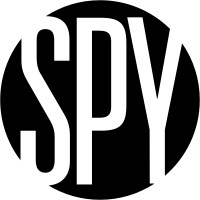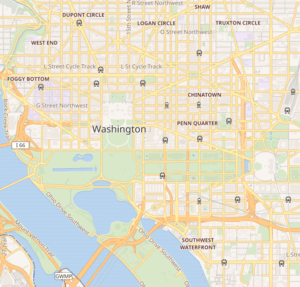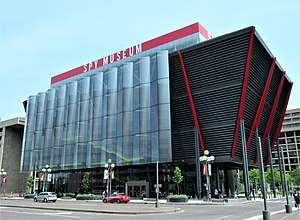International Spy Museum
The International Spy Museum is a private non-profit museum dedicated to the tradecraft, history and contemporary role of espionage, featuring the largest collection of international espionage artifacts currently on public display. The museum opened in 2002 in the Penn Quarter neighborhood of Washington, D.C., and relocated to L'Enfant Plaza in 2019.[2][3]
 | |
 Location within Washington, D.C. | |
| Established | July 19, 2002 |
|---|---|
| Location | 700 L'Enfant Plaza, SW Washington, DC United States |
| Coordinates | 38.884°N 77.02551°W |
| Visitors | Approx. 600,000 annually[1] |
| Director | Christopher P. Costa |
| Public transit access | |
| Website | SpyMuseum.org |
History
The museum was conceptualized in 1996 as a for-profit organization by Milton Maltz of The Malrite Company. Maltz, a code-breaker during the Korean War, founded the Malrite Communications Group in 1956, which later became The Malrite Company, and was CEO until it was sold in 1998.[4] The original museum facility in the Penn Quarter neighborhood was built by Milton Maltz and The House on F Street, L.L.C. at a cost of approximately US$40 million.[5] It opened to the public in 2002.[6] It is one of the few museums in Washington DC that charges admission fees.[7]
The Malrite Company provided half of the foundation cost of the International Spy Museum. The other US$20 million came from the District of Columbia as enterprise zone bonds and TIF bonds. The museum was part of the ongoing rejuvenation of Penn Quarter, kicked off in the 1980s by the Pennsylvania Avenue Development Corporation.[8]
In April 2015, plans for a new museum designed by Rogers Stirk Harbour + Partners were released.[2] In January 2019, the museum began the process of moving from its previous F Street location to the new US$162 million dedicated building at 700 L’Enfant Plaza, and it reopened to the public on May 12, 2019.[9] The new building includes a 145-seat theater, rooftop terrace and top-floor event space.[10] The move increased the Spy Museum's exhibit space from 19,000 to 32,000 square feet.
Permanent collection

More than 750 artifacts are on public display within the 20,000 square feet (1900 m²) of exhibition space, supported with historic photographs, interactive displays, film, and video. The permanent collection traces the complete history of espionage, from the Egyptian, Greek and Roman empires, the Middle Ages, the Renaissance, the British Empire, the American Revolutionary War, the American Civil War, both World Wars, the Cold War, and through present day espionage activity. Exhibits include:
Covers & Legends: Visitors begin their mission by adopting a cover identity and learning why an agent needs one. They are then led into the Briefing Room to be introduced to the real world of espionage.
School for Spies: This section provides an introduction to the tradecraft of espionage and describes many of the skills and tools essential to a spy. It explores the different motivations that lead people into the clandestine world, how they are recruited and trained, and how they operate.
The Secret History of History: This series of galleries chronicles the history of spying from biblical times to the early 20th century. It explores such phenomena as the institutionalization of spying in the early years of the Soviet Union and traces the rise of espionage technology, such as spy photography. It also examines the role that women have played in espionage and reveals well-known historical figures who were also spymasters, including George Washington and author Daniel Defoe.
Spies Among Us: These exhibits, films, and videos examine espionage through World War II, showcasing real-life spy stories. They explore the role of code-making and code-breaking operations and teach various ways to create, break and hide coded messages through interactive exhibits. An exhibit on celebrity spies details famous figures who had separate careers in espionage unbeknownst to the public, including singer Josephine Baker, chef Julia Child, baseball legend Moe Berg, movie director John Ford, and actress Marlene Dietrich.
The 21st Century: The challenges facing intelligence professionals worldwide in the 21st Century are addressed in the film Ground Truth. The looming threat of Cyber War is addressed in Weapons of Mass Disruption.
Operation Spy
The museum had an interactive exhibit called Operation Spy, where visitors assumed the roles of covert agents and participated in a one-hour Hollywood-style spy simulation, in which they moved from area to area and were faced with puzzles, tasks, motion simulators, sound effects, and video messages as they worked through a mission involving the interception of a secret arms deal involving a nuclear trigger. This activity had a separate admission fee and separate entrance from the museum's permanent exhibit. This activity is currently unavailable at the SPY Museum.
Spy in the City
In the spring of 2009, the museum began an interactive called Spy in the City where visitors are given a GPS-type device and tasked with finding clues near various landmarks in the area surrounding the museum, for the purposes of fulfilling a mission of obtaining the password for a secret weapon. This activity is currently unavailable at the Spy museum.
Educational programs
A wide range of educational and cultural programs are offered for students, adults, and families including scholarly lectures; films; book signings; hands-on workshops; student, adult and senior group tour packages; and other special events throughout the year.
Museum store
The International Spy Museum's new 5,000 square foot store at L'Enfant Plaza features a diverse selection of merchandise that mirrors the Museum's presentation of the tradecraft and history of espionage with a dedicated intelligence library and children's reading area.
In popular culture
- The museum was used as a setting in the Season 3 episode of Fetch! with Ruff Ruffman entitled "Mission Improbable". It was where Ruff sent the FETCHers to learn about how to become spies.
- The museum was referenced in Season 4 Episode 4 of Madam Secretary. Elizabeth McCord's son is doing a school report on the CIA, so Elizabeth and Tim plan to bring him to the Spy Museum.
See also
- CIA Museum
- Imperial War Museum
- National Cryptologic Museum
- Spyscape
- Hilton Washington Dc National Mall
References
- Kennicott, Philip (May 7, 2019). "The best part of the new Spy Museum? Its exterior". The Washington Post. Retrieved 7 July 2019.
- Goldchain, Michelle (23 April 2015). "What to Expect From the Brand New International Spy Museum". Curbed. Retrieved 2015-07-11.
- "You can buy advance tickets online to the bigger Spy Museum, which opens May 12"
- Folkinshteyn, Benjamin, “Washington as First Action Hero: Museums Redefined,” DePaul Journal of Art, Technology & Intellectual Property Law (Fall 2007): 8.
- Radosh, Ronald (2010). "Scoping Out The International Spy Museum". Academic Questions. 3. 23: 287–297. doi:10.1007/s12129-010-9171-1.
- Ensor, David (2002-7-19) "Poison umbrellas, lethal lipstick: Spy museum opens". CNN. Retrieved August 16, 2013.
- "Tickets" Archived 2017-05-17 at the Wayback Machine. International Spy Museum. Retrieved August 16, 2013.
- "36 C.F.R. Chapter IX – Pennsylvania Avenue Development Corporation". Retrieved April 22, 2011.
- "The new Spy Museum is bigger, bolder and more beautiful. Here are the 10 things you shouldn't miss".
- "Spy Museum says goodbye to Penn Quarter". Washington Business Journal. Retrieved December 31, 2018.
External links
| Wikimedia Commons has media related to International Spy Museum. |